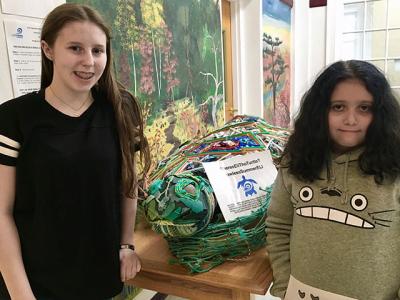Waging a War on Straws

Approximately 19 billion pounds of plastic waste ends up in the world’s oceans every year. Several ocean conservancy groups have cautioned that if we keep polluting at the current rate there will be more plastic than fish in the ocean by 2050.
By that time, Sarah Betuel, an eighth grader at the East Hampton Middle School, will be about 45 years old, which is why she decided to do something right now about this disturbing outlook.
Sarah is spearheading an initiative called Strawless Summer, introduced by the Surfrider Foundation, a grassroots nonprofit environmental organization that works to protect and preserve the world’s oceans and beaches through a powerful activist network. She is the student president of the middle school’s Surfrider Club, overseen by the Long Island chapter of the organization. The club is offered as an after-school activity.
“Our goal is to target all East Hampton restaurants,” Sarah said last week in John Ryan’s classroom on Newtown Lane. Mr. Ryan not only teaches sixth-grade math but, together with Lisa Lawler, a fellow sixth-grade teacher, is also the adviser of the Surfrider Club and a longtime rescue swimmer with East Hampton Volunteer Ocean Rescue.
Members of the after-school club, explained Sarah, will send letters to all restaurants and bars in East Hampton asking them to sign a pledge either to go completely strawless or provide reusable alternatives such as stainless steel or glass, or, upon request, paper or bamboo straws. Letters will be followed up by an in-person visit, she said.
Helping her at the helm of this environmental campaign will be Maya Guzman, a sixth grader who was also in Mr. Ryan’s classroom last week.
“If restaurants agree not to use plastic straws over the summer,” said Maya, “then we’ll ask them to advertise their pledge on their websites.” The school’s student government will join in the effort.
To remind middle school students and staffers to do their part in reducing plastic waste, a Surfrider Club mascot sat in the school’s front hall last week: Eli the Turtle, made entirely out of ocean debris, his shell formed from colorful straws crisscrossed over more straws, twine, and pieces of plastic. At a recent beach cleanup in Greenport, the Eastern Long Island Chapter of Surfrider removed 922 straws from the shoreline.
This is not the first time Sarah has championed an environmental push. Two years ago, she wrote a letter to the middle school’s parent advisory committee asking that the Styrofoam plates in the cafeteria be replaced by biodegradable ones. Her request was successful.
She had already written to the parent committee requesting an end to plastic straws in the cafeteria when the Surfrider Strawless Summer initiative was introduced. It was perfect timing for Sarah to expand her campaign from the cafeteria to the neighborhood, Mr. Ryan said.
Plastic straws were the target last year of fourth graders in Montauk, when, with the help of their teachers, Chantal Adamcewicz and Kathy Havlik, the stu dents urged a few local restaurants to ban them, and largely succeeded. Bliss Kitchen was the first to jump onboard. Last week, it was reported that Gosman’s Dock restaurants have also switched to paper straws.
While plastic bags and soda-can rings regularly top the list of hazardous ocean pollutants, few realize that plastic straws are one of the most insidious polluters, because they entangle marine animals and are consumed by fish. A video of scientists removing a straw embedded in the nose of a sea turtle went viral in 2015.
Small and lightweight, straws often fail to make it through the mechanical recycling sorter. As a result, they drop through sorting screens and contaminate recycling loads, or they simply get disposed of as garbage — the evidence of which is clearly visible on many beaches. According to the Ocean Conservancy, based in Washington, D.C., plastic straws and stirrers were number five on a 2013 Ocean Trash Index. National Geographic reported that Americans use an average of 500 million plastic straws a day.
There is a global environmental movement developing, hoping to raise public awareness of this massive problem. Sarah and Maya, along with other young South Fork environmentalists, are certainly doing their part to address plastic pollution. Maya said her motivation to join the after-school Surfrider Club stemmed from her love for animals and desire to help ocean creatures at risk. As for Sarah, who has been president of the club for three years, environmental issues are her passion. “I just want to help and improve the environment,” she said.
